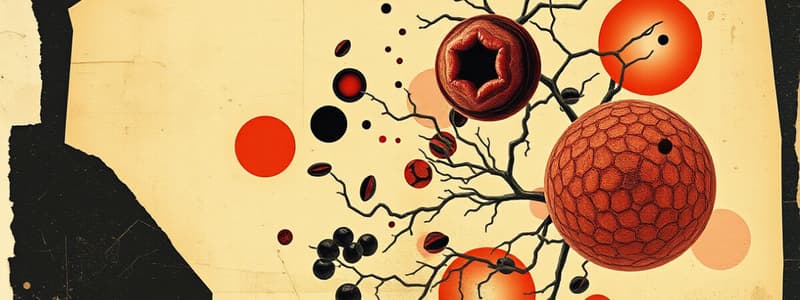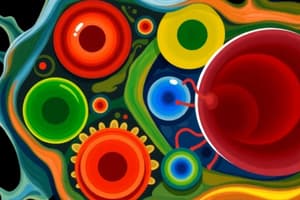Podcast
Questions and Answers
What is the role of the cell nucleus?
What is the role of the cell nucleus?
The nucleus contains nearly all the cell's DNA and, with it, the coded instructions for making proteins and other important molecules.
What are the functions of vacuoles, lysosomes, and the cytoskeleton?
What are the functions of vacuoles, lysosomes, and the cytoskeleton?
Vacuoles store materials like water, salts, proteins, and carbohydrates. Lysosomes break down lipids, carbohydrates, and proteins into small molecules. The cytoskeleton helps the cell maintain its shape and is also involved in movement.
What organelles help make and transport proteins?
What organelles help make and transport proteins?
Ribosomes, rough ER, and Golgi apparatus help make and transport proteins.
What are the functions of chloroplasts and mitochondria?
What are the functions of chloroplasts and mitochondria?
What is the function of the cell membrane?
What is the function of the cell membrane?
What is cytoplasm?
What is cytoplasm?
What are organelles?
What are organelles?
What are vacuoles?
What are vacuoles?
What do lysosomes do?
What do lysosomes do?
What is the cytoskeleton?
What is the cytoskeleton?
What are microfilaments?
What are microfilaments?
What are microtubules?
What are microtubules?
What are centrioles?
What are centrioles?
What are ribosomes?
What are ribosomes?
What is the endoplasmic reticulum (ER)?
What is the endoplasmic reticulum (ER)?
What is the Golgi apparatus?
What is the Golgi apparatus?
What do chloroplasts do?
What do chloroplasts do?
What do mitochondria do?
What do mitochondria do?
What is the cell wall?
What is the cell wall?
What is a lipid bilayer?
What is a lipid bilayer?
What is the function of the cell membrane?
What is the function of the cell membrane?
Most biological membranes are selectively permeable.
Most biological membranes are selectively permeable.
Flashcards are hidden until you start studying
Study Notes
Cell Nucleus
- Contains nearly all of the cell's DNA.
- Provides coded instructions for protein synthesis and production of important molecules.
Vacuoles, Lysosomes, and Cytoskeleton
- Vacuoles: Store materials like water, salts, proteins, and carbohydrates.
- Lysosomes: Break down lipids, carbohydrates, and proteins; also degrade worn-out organelles.
- Cytoskeleton: Maintains cell shape and facilitates movement.
Protein Synthesis and Transport
- Ribosomes: Sites for protein assembly, found throughout the cytoplasm.
- Rough Endoplasmic Reticulum (ER): Produces proteins for secretion and membrane proteins.
- Golgi Apparatus: Modifies, sorts, and packages proteins from the ER for storage or export.
Chloroplasts and Mitochondria
- Chloroplasts: Capture sunlight energy, convert it to chemical energy through photosynthesis.
- Mitochondria: Convert chemical energy from food into usable cellular compounds.
Cell Membrane
- Regulates entry and exit of substances in and out of the cell.
- Provides protection and support to the cell.
Cytoplasm
- The portion of the cell found outside the nucleus.
Organelles
- Defined as mini organs, each performing a specific function within the cell.
Microfilaments and Microtubules
- Microfilaments: Threadlike structures composed of actin protein.
- Microtubules: Hollow structures formed from tubulin proteins.
Centrioles
- Located near the nucleus; play a role in organizing cell division.
Endoplasmic Reticulum (ER)
- Site for the assembly of lipid components and proteins that are exported from the cell.
Cell Wall
- A supportive and protective layer surrounding the cell membrane, found in plant cells.
Lipid Bilayer
- Comprises the cell membrane structure, forming a barrier between internal and external environments.
Selectively Permeable
- Biological membranes allow certain substances to pass while blocking others.
Studying That Suits You
Use AI to generate personalized quizzes and flashcards to suit your learning preferences.





